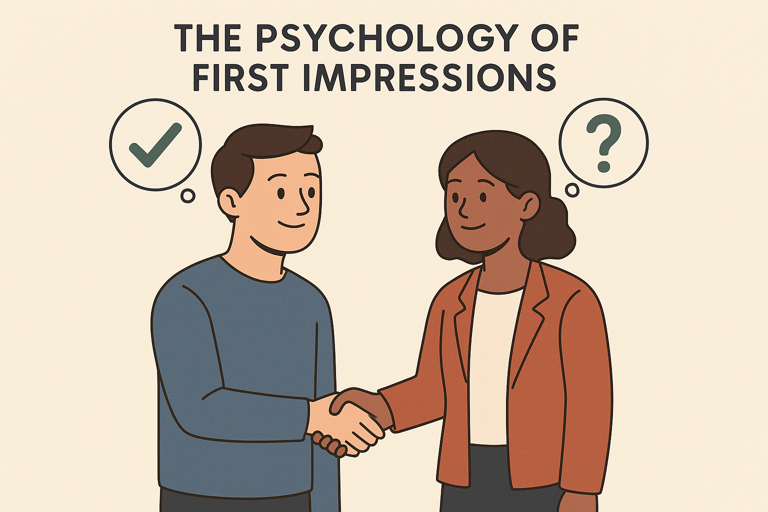
The Psychology of First Impressions: How People Judge and Are Judged
Introduction
We’ve all heard the saying, “You never get a second chance to make a first impression.” And as it turns out, there’s a lot of truth behind those words. In just a few seconds of meeting someone, our brains form opinions that can last for a long time — even if they’re not entirely accurate.
But why do we form judgments so quickly? And what factors affect how we are seen by others? Understanding the psychology of first impressions helps us become more aware of how we present ourselves and how we perceive those around us.
What Is a First Impression?
A first impression is the initial judgment we make about a person when we meet them. It happens fast — usually within the first 7 to 30 seconds. Sometimes, even a glance is enough to form a basic opinion.
This snap judgment is mostly subconscious. Our brains gather visual, verbal, and behavioral clues and use them to create an overall picture. From appearance to tone of voice to posture, everything plays a role.
Why Do We Judge So Quickly?
From an evolutionary perspective, quick judgments helped humans survive. Early humans needed to decide quickly if someone was a threat or an ally. That fast thinking still lives in our brains today. Now, instead of judging for safety, we judge for personality, trustworthiness, intelligence, or friendliness.
Our brains like shortcuts — and first impressions are mental shortcuts. We may not realize it, but these fast judgments influence how we behave around others, how much we trust them, and how we communicate.
What Do People Notice First?
When forming a first impression, people pay attention to many subtle cues, including:
- Appearance: Clothing, grooming, posture, and facial expressions are among the first things noticed. People often associate neatness and confidence with competence and trustworthiness.
- Body Language: Open gestures, eye contact, and a relaxed posture signal approachability, while crossed arms or lack of eye contact may suggest discomfort or disinterest.
- Voice and Tone: A warm, calm voice is often seen as friendly and confident, while a loud or monotone voice may come across as aggressive or bored.
- Facial Expression: A genuine smile creates a sense of connection and safety. Our brains are highly sensitive to facial cues, even the most subtle ones.
How Do Biases Affect First Impressions?
First impressions aren’t always fair. Personal experiences, beliefs, and stereotypes all influence how we view others. These unconscious biases can affect judgment without us even realizing it.
For example, people may associate certain accents, clothing styles, or physical features with specific traits — even if there’s no real connection. Recognizing these biases is the first step toward making more thoughtful and accurate judgments.
Can First Impressions Be Changed?
While first impressions are powerful, they’re not unchangeable. People can revise their opinions once they get to know someone better — but it usually takes time and consistent behavior to undo a negative impression.
That’s why it’s so important to be intentional during first meetings. A positive start can open doors to trust and meaningful relationships, whether in work, friendships, or social situations.
How to Make a Strong First Impression
If you want to leave a positive impression on someone you meet, here are some simple, practical tips:
1. Be Present
Put away distractions and focus on the person in front of you. Giving someone your full attention is a powerful sign of respect.
2. Smile Naturally
A real smile makes people feel at ease. It’s a universal signal of friendliness and warmth.
3. Use Open Body Language
Stand or sit upright, make eye contact, and avoid crossing your arms. These signals show you’re open, confident, and interested.
4. Speak Clearly and Kindly
The way you speak matters. Use a friendly tone, speak at a comfortable pace, and show interest through your words and questions.
5. Dress Appropriately
Choose clothing that fits the setting. It’s not about fashion — it’s about showing effort and respect for the situation.
6. Listen More Than You Talk
People remember how you make them feel. Listening shows that you value what they have to say.
How to Avoid Misjudging Others
Being on the receiving end of a judgment is one thing — but we also need to be aware of how we judge others. To form fairer impressions:
- Slow down. Don’t assume you know someone after just a few seconds.
- Keep an open mind. Everyone has a story that may not be obvious at first glance.
- Reflect on your own reactions. Ask yourself why you feel a certain way about someone — is it based on facts or assumptions?
Conclusion
First impressions are fast and powerful, but not always accurate. They help us make sense of the people we meet — but they can also be shaped by bias and instinct. By understanding how these judgments work, we can be more thoughtful in how we present ourselves and more open-minded in how we see others.
Whether you’re meeting someone for a job interview, on a date, or just saying hello to a stranger, those first moments matter. With awareness and intention, you can make them count.